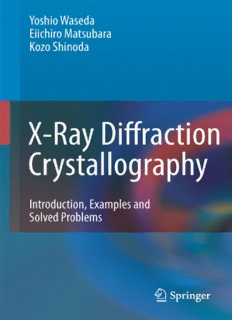Table Of ContentX-Ray Diffraction Crystallography
Yoshio Waseda (cid:2) Eiichiro Matsubara
Kozo Shinoda
X-Ray Diffraction
Crystallography
Introduction, Examples and Solved Problems
With159Figures
123
ProfessorDr.YoshioWaseda
ProfessorKozoShinoda
TohokuUniversity,InstituteofMultidisciplinaryResearchforAdvancedMaterials
Katahira2-1-1,980-8577Sendai,Aoba-ku,Japan
E-mail:[email protected];[email protected]
ProfessorDr.EiichiroMatsubara
KyotoUniversity,GraduateSchoolofEngineering
DepartmentofMaterialsScienceandEngineering
YoshidaHonmachi,606-8501Kyoto,Sakyo-ku,Japan
E-mail:[email protected]
Supplementary problems withsolutions areaccessible toqualified instructors atspringer.com onthis
book’sproductpage.Instructorsmayclickonthelinkadditionalinformationandregistertoobtaintheir
restrictedaccess.
ISBN978-3-642-16634-1 e-ISBN978-3-642-16635-8
DOI10.1007/978-3-642-16635-8
SpringerHeidelbergDordrechtLondonNewYork
LibraryofCongressControlNumber:2011923528
(cid:2)c Springer-VerlagBerlinHeidelberg2011
Thisworkissubjecttocopyright.Allrightsarereserved,whetherthewholeorpartofthematerialis
concerned,specificallytherightsoftranslation,reprinting,reuseofillustrations,recitation,broadcasting,
reproductiononmicrofilmorinanyotherway,andstorageindatabanks.Duplicationofthispublication
orpartsthereofispermittedonlyundertheprovisionsoftheGermanCopyrightLawofSeptember9,
1965,initscurrentversion,andpermissionforusemustalwaysbeobtainedfromSpringer.Violations
areliabletoprosecutionundertheGermanCopyrightLaw.
Theuseofgeneral descriptive names, registered names,trademarks, etc. inthis publication does not
imply,evenintheabsenceofaspecificstatement,thatsuchnamesareexemptfromtherelevantprotective
lawsandregulationsandthereforefreeforgeneraluse.
Coverdesign:eStudioCalamarSteinen
Printedonacid-freepaper
SpringerispartofSpringerScience+BusinessMedia(www.springer.com)
Preface
X-raydiffractioncrystallographyforpowdersamplesiswell-establishedandwidely
used in the field of materials characterizationto obtain informationon the atomic
scale structure of various substances in a variety of states. Of course, there have
beennumerousadvancesinthisfield,sincethediscoveryofX-raydiffractionfrom
crystalsin1912byMaxvonLaueandin1913byW.L.BraggandW.H.Bragg.The
originofcrystallographyistracedtothestudyfortheexternalappearanceofnatural
mineralsandalargeamountofdatahavebeensystematizedbyapplyinggeometry
andgrouptheory.Then,crystallographybecomesavaluablemethodforthegeneral
consideration of how crystals can be built from small units, correspondingto the
infiniterepetitionofidenticalstructuralunitsinspace.
Many excellent and exhaustivebooks on X-ray diffraction and crystallography
are available,butthe undergraduatestudentsandyoungresearchersand engineers
whowishtobecomeacquaintedwiththissubjectfrequentlyfindthemoverwhelm-
ing.Theyfinditdifficulttoidentifyandunderstandtheessentialpointsinthelimited
time available to them, particularly on how to estimate useful structural informa-
tion from the X-ray diffractiondata. Since X-ray powder diffractionis one of the
mostcommonandleadingmethodsinmaterialsresearch,masteryofthesubjectis
essential.
InordertolearnthefundamentalsofX-raydiffractioncrystallographywelland
to be able to cope with the subject appropriately,a certain number of “exercises”
involvingcalculationofspecificpropertiesfrommeasurementsarestronglyrecom-
mended.ThisisparticularlytrueforbeginnersofX-raydiffractioncrystallography.
RecentgeneralpurposeX-raydiffractionequipmentshavealotofinbuiltautoma-
tion for structural analysis. When a sample is set in the machine and the preset
buttonispressed,resultsareautomaticallygeneratedsomeofwhicharemisleading.
Agoodunderstandingoffundamentalshelpsonetorecognizemisleadingoutput.
During the preparation of this book, we have tried to keep in mind the stu-
dents who come across X-ray diffraction crystallography for powder samples at
the first time. The primaryobjectiveis to offera textbookto studentswith almost
nobasic knowledgeofX-raysanda guidebookforyoungscientistsandengineers
engaged in full-scale materials development with emphasis on practical problem
solving.Fortheconvenienceofreaders,someessentialpointswithbasicequations
v
vi Preface
aresummarizedineachchapter,togetherwithsomerelevantphysicalconstantsand
atomicscatteringfactorsofelementslistedinappendices.
SincepracticeperfectstheacquisitionofskillsinX-raydiffractioncrystallogra-
phy, 100 supplementary problems are also added with simple solutions. We hope
that the students will try to solve these supplementaryproblemsby themselvesto
deepentheirunderstandingandcompetenceofX-raycrystallographywithoutseri-
ousdifficulty.SincethefieldofX-raystructuralanalysisofmaterialsisquitewide,
notallpossibleapplicationsarecovered.Thesubjectmatterinthisbookisrestricted
tofundamentalknowledgeofX-raydiffractioncrystallographyforpowdersamples
only.Thereaderscanrefertospecializedbooksforotherapplications.
The production of high-quality multi-layered thin films with sufficient relia-
bility is an essential requirement for device fabrication in micro-electronics. An
iron-containing layered oxy-pnictide LaO1(cid:3)xFxFeAs has received much attention
becauseitexhibitssuperconductivitybelow43KasreportedrecentlybyDr.Hideo
HosonoinJapan.Theinterestingpropertiesofsuchnewsyntheticfunctionalmate-
rials are linked to their periodic and interfacial structures at a microscopic level,
althoughtheoriginofsuchpeculiarfeatureshasnotbeenfullyunderstoodyet.Nev-
ertheless,ourunderstandingofmostofthe importantpropertiesofnewfunctional
materialsreliesheavilyupontheiratomicscalestructure.Thebeneficialutilization
of all materials should be pursued very actively to contribute to the most impor-
tanttechnologicalandsocialdevelopmentsofthe twenty-firstcenturyharmonized
withnature.Drivenbyenvironmentalconcerns,theinterestintherecoveryorrecy-
clingofvaluablemetallicelementsfromwastessuchasdiscardedelectronicdevices
will grow significantly over the next decade. The atomic scale structure of vari-
ousmaterialsin a varietyofstatesisessentialfromboththebasic scienceandthe
appliedengineeringpointsofview.Ourgoalistotakethemostefficientapproach
for describing the link between the atomic scale structure and properties of any
substanceofinterest.
The content of this book has been developed through lectures given to under-
graduate or junior-levelgraduate students in their first half (Master’s program) of
thedoctoralcourseofthegraduateschoolofengineeringatbothTohokuandKyoto
universities.Ifthisbookisusedasareferencetosupplementlecturesinthefieldof
structuralanalysisofmaterialsorasaguideforaresearcherorengineerengagedin
structuralanalysistoconfirmhisorherdegreeofunderstandingandtocompensate
fordeficiencyinself-instruction,itisanexceptionaljoyforus.
Many people have helped both directly or indirectly in preparing this book.
The authors are deeply indebted to Professors Masahiro Kitada for his valuable
advice on the original manuscript. Many thanks are due to Professor K.T. Jacob
(Indian Institute of Science, Bangalore), Professor N.J. Themelis (Columbia Uni-
versity), Professor Osamu Terasaki (Stockholm University) and Dr.Daniel Gru¨ner
andDr.KarinSo¨derberg(StockholmUniversity)andDr. SamStevens(University
ofManchester)whoreadthemanuscriptandmademanyhelpfulsuggestions.
The authors would like to thank Ms. Noriko Eguchi, Ms. Miwa Sasaki and
Mr.YoshimasaItofortheirassistanceinpreparingfiguresandtablesaswellasthe
electronicTeXtypesetofthisbook.Theauthorsarealsoindebtedtomanysources
Preface vii
of materialin this article. The encouragementof Dr. Claus Ascheronof Springer-
Verlag,Mr.SatoruUchidaandManabuUchidaofUchida-RokakuhoPublishingLtd
shouldalsobeacknowledged.
Sendai,Japan YoshioWaseda
January2011 EiichiroMatsubara
KozoShinoda
Note:Asolutionmanualfor100supplementaryproblemsisavailabletoinstructors
who have adopted this book for regular classroom use or tutorial seminar use. To
obtain a copy of the solution manual, a request may be delivered on your depart-
mentalletterheadtothepublisher(orauthors),specifyingthepurposeofuseasan
organization(notpersonal).
Contents
1 FundamentalPropertiesofX-rays .......................................... 1
1.1 NatureofX-rays......................................................... 1
1.2 ProductionofX-rays..................................................... 3
1.3 AbsorptionofX-rays.................................................... 5
1.4 SolvedProblems(12Examples)........................................ 6
2 GeometryofCrystals ......................................................... 21
2.1 LatticeandCrystalSystems............................................. 21
2.2 LatticePlanesandDirections ........................................... 26
2.3 PlanesofaZoneandInterplanarSpacing .............................. 30
2.4 StereographicProjection ................................................ 31
2.5 SolvedProblems(21Examples)........................................ 35
3 ScatteringandDiffraction.................................................... 67
3.1 ScatteringbyaSingleElectron ......................................... 67
3.2 ScatteringbyaSingleAtom............................................. 69
3.3 DiffractionfromCrystals................................................ 73
3.4 ScatteringbyaUnitCell ................................................ 76
3.5 SolvedProblems(13Examples)........................................ 80
4 Diffraction from Polycrystalline Samples
andDeterminationofCrystalStructure....................................107
4.1 X-rayDiffractometerEssentials.........................................107
4.2 Estimation of X-ray Diffraction Intensity
fromaPolycrystallineSample ..........................................108
4.2.1 StructureFactor..................................................109
4.2.2 PolarizationFactor ..............................................109
4.2.3 MultiplicityFactor...............................................110
4.2.4 LorentzFactor ...................................................110
4.2.5 AbsorptionFactor ...............................................111
ix
Description:X-ray diffraction crystallography for powder samples is well-established and widely atomic scattering factors of elements listed in appendices.

